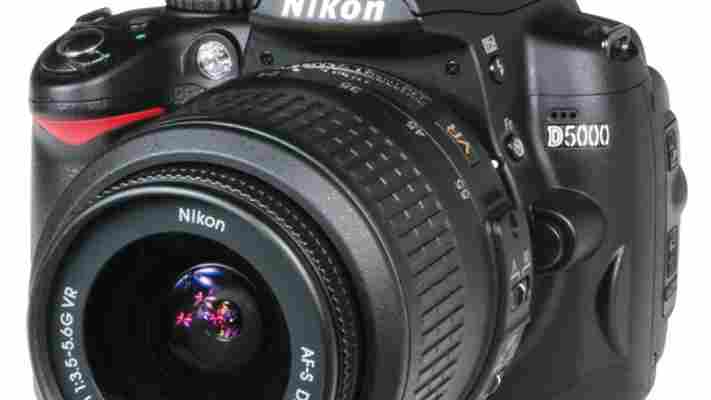The digital SLR market is busier than ever, with Canon, Olympus, Sony and now Nikon each offering three models under £1,000.
The D5000 sits between the smaller, lighter and cheaper D60 and the pricier, bulkier, feature-packed D90. Its 4fps continuous shooting speed also nestles between the two.
The D5000 inherits the D90's live view mode for composing shots on the screen. Autofocus becomes hopelessly slow in this mode, so the viewfinder is more practical, but live view is handy when shooting at awkward angles. It helps that the 2.7in LCD screen can tilt up and down or twist right around for self-portraits - a first for a Nikon SLR. The screen's 230,000-dot resolution is disappointing at this price, though.
The D5000 also shares the D90's video-capture mode. Videos are recorded at 1,280x720, and the big sensor excels at low-light video capture. However, clips are limited to five minutes, focus is fixed and the exposure lurches awkwardly in variable lighting. As with the D90 and Canon's EOS 500D (What's New, Shopper 259), the video mode is an interesting extra but won't replace a dedicated camcorder.
Other features shared with the D90 include an HDMI output and an 11-point autofocus system. The latter proved to be reliable but was a little lethargic in low light. It has the same 12.2-megapixel CMOS sensor, 100-to-6400 ISO range and automatic removal of chromatic aberrations, which reduces multicoloured fringing in areas of high contrast.
Other features are more in line with the D60. The kit lens is the same basic 3x zoom model, and the camera's lack of a focus motor limits the choice of other lenses. The viewfinder is smaller than the D90's, and with barely any single-function buttons on the camera, key settings must be adjusted via the menu system. The D60's dual-function button, which caused us much frustration, is split over two buttons here. However, the D90's commands are far superior, as are the controls on Canon's EOS models.
Image quality was superb. Colour reproduction was excellent, with skin tones that struck a pleasing balance between realism and flattering warmth. The kit lens and chromatic aberration removal produced significantly better corner sharpness than Canon's 500D and its kit lens. These two cameras were level pegging for noise, with both turning in excellent results at ISO 3200.
The D5000 is almost a superb camera but its control system lets it down. We prefer it to Canon's 500D, but the Nikon D90's better controls, bigger viewfinder, higher-resolution screen, wider lens compatibility and 5.8x zoom kit lens make it worth the extra £120. Bargain hunters should go for Canon's 1000D.
Basic Specifications | |
|---|---|
| Rating | **** |
| CCD effective megapixels | 12.2 megapixels |
| CCD size | 23.6x15.8mm |
| Viewfinder | optical TTL |
| LCD screen size | 2.7in |
| LCD screen resolution | 230,000 pixels |
| Optical zoom | 3.0x |
| Zoom 35mm equivalent | 27-82.5mm |
| Image stabilisation | optical, lens based |
| Maximum image resolution | 4,288x2,848 |
| Maximum movie resolution | 1280x720 |
| Movie frame rate at max quality | 24fps |
| File formats | JPEG, RAW; AVI (M-JPEG) |
Physical | |
| Memory slot | SDHC |
| Mermory supplied | none |
| Battery type | 7.2V 1,080mAh Li-ion |
| Battery Life (tested) | 510 shots |
| Connectivity | USB, AV, mini HDMI, GPS input, remote input |
| Body material | plastic |
| Accessories | USB and AV cables, neck strap |
| Weight | 765g |
| Size | 104x127x151mm |
Buying Information | |
| Price | £620 |
| Supplier | http://www.amazon.co.uk |
| Details | www.nikon.co.uk |
Camera Controls | |
| Exposure modes | program, shutter priority, aperture priority, manual |
| Shutter speed | 30 to 1/4,000 seconds |
| Aperture range | f/3.5 to f/22 (wide), f/5.6 to f/36 (tele) |
| ISO range (at full resolution) | 100 to 6400 (equivalent) |
| Exposure compensation | +/-5 EV |
| White balance | auto, 6 presets, manual |
| Additional image controls | contrast, saturation, sharpness, brightness, hue, high-ISO noise reduction, long-exposure noise reduction, Active D-Lighting |
| Manual focus | Yes |
| Closest macro focus | 28cm |
| Auto-focus modes | 11-point, face detect, 3D tracking |
| Metering modes | multi, centre-weighted, centre, face detect |
| Flash | auto, forced, suppressed, slow synchro, rear curtain, red-eye reduction |
| Drive modes | single, continuous, self-timer, AE bracket |







Leave a Reply